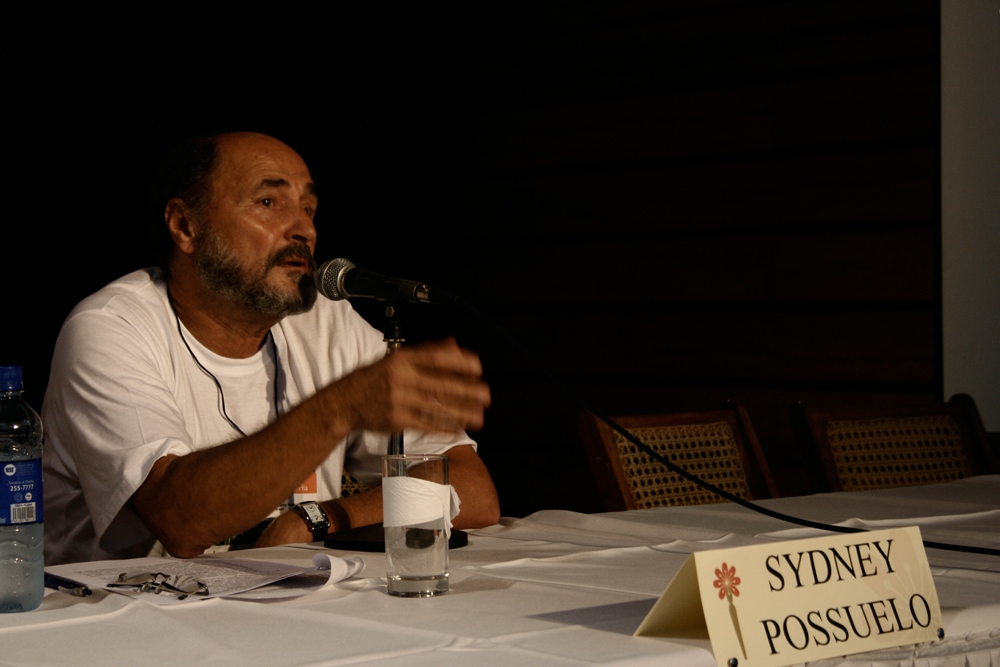|
Korubo
The Korubo or Korubu, also known as the Dslala, are an indigenous people of Brazil living in the lower Vale do Javari in the western Amazon Basin. The group calls themselves 'Dslala', and in Portuguese they are referred to as ''caceteiros'' (clubbers). Much of what the outside world knows of this group is based on the research of Brazilian explorer Sydney Possuelo, who first contacted the tribe in October 1996, and journalist Paul Raffaele. The Korubo are some of the last people on Earth to live in near- isolation from modern society, although they have, on numerous occasions, had violent contacts with the surrounding communities. An offshoot of the group is led by a woman named Maya. This splinter group has around 23 members, while the larger group is estimated to have 150 members. Culture Their hunting and war weapon of choice is the club, and aside from poison darts they use no other ranged weapons - their workday is about 4–5 hours long, and often live inside large, com ... [...More Info...] [...Related Items...] OR: [Wikipedia] [Google] [Baidu] |
Korubo Language
Korubo is a nearly extinct Panoan language spoken by the Korubo The Korubo or Korubu, also known as the Dslala, are an indigenous people of Brazil living in the lower Vale do Javari in the western Amazon Basin. The group calls themselves 'Dslala', and in Portuguese they are referred to as ''caceteiros'' (clu ... people of Brazil. There are two dialects, Korubo itself and moribund Chankueshbo (Fleck 2013). Phonology Korubo has 6 vowels: /a, e, i, ɨ, o, u/. References Indigenous languages of Western Amazonia Panoan languages {{IndigenousAmerican-lang-stub ... [...More Info...] [...Related Items...] OR: [Wikipedia] [Google] [Baidu] |
Panoan Languages
Panoan (also Pánoan, Panoano, Panoana, Páno) is a family of languages spoken in Peru, western Brazil, and Bolivia. It is possibly a branch of a larger Pano–Tacanan family. Genetic relations The Panoan family is generally believed to be related to the Tacanan family, forming with it Pano–Tacanan, though this has not yet been established (Loos 1999). Language contact Jolkesky (2016) notes that there are lexical similarities with the Kechua, Mapudungun, Moseten-Tsimane, Tukano, Uru-Chipaya, Harakmbet, Arawak, Kandoshi, and Pukina language families due to contact. Languages There are some 18 extant and 14 extinct Panoan languages.Fleck, David. 2013. Panoan Languages and Linguistics'. Anthropological Papers of the American Museum of Natural History 99. In the list of Panoan languages below adapted from Fleck (2013), (†) means extinct, and (*) obsolescent (no longer spoken daily). Dialects are listed in parentheses. *Mayoruna ** Tabatinga Mayoruna ost divergent† ... [...More Info...] [...Related Items...] OR: [Wikipedia] [Google] [Baidu] |
Indigenous Peoples In Brazil
Indigenous peoples in Brazil ( pt, povos indígenas no Brasil) or Indigenous Brazilians ( pt, indígenas brasileiros, links=no) once comprised an estimated 2000 tribes and nations inhabiting what is now the country of Brazil, before European contact around 1500. Christopher Columbus thought he had reached the East Indies, but Portuguese Vasco da Gama had already reached India via the Indian Ocean route, when Brazil was colonized by Portugal. Nevertheless, the word ("Indians") was by then established to designate the people of the New World and continues to be used in the Portuguese language to designate these people, while a person from India is called in order to distinguish the two. At the time of European contact, some of the Indigenous people were traditionally semi-nomadic tribes who subsisted on hunting, fishing, gathering and migrant agriculture. Many tribes suffered extinction as a consequence of the European settlement and many were assimilated into the Brazilian po ... [...More Info...] [...Related Items...] OR: [Wikipedia] [Google] [Baidu] |
Sydney Possuelo
Sydney Ferreira Possuelo (born 19 April 1940, in Santos Dumont), is a Brazilian explorer, social activist and ethnographer who is considered the leading authority on Brazil's remaining isolated Indigenous Peoples. Life and career Sydney Possuelo started his career assisting the famous Villas Boas brothers with their work among indigenous peoples of the Xingu River area. Later he became the Director of the Department of Indigenous in Isolation (Departamento de Indios Isolados) at the FUNAI (National Indian Foundation of Brazil), doubling the surface size of officially designated Indigenous land in Brazil in only two years. Working in the most isolated areas in the Amazon region, Possuelo has led many expeditions, getting in contact with isolated tribes in Brazil, with the aim to protect them from outsiders. He was responsible, among others, for the restoration of peaceful contact with the Korubo Indians, who had previously killed some FUNAI officials. Until January 24, 2006 h ... [...More Info...] [...Related Items...] OR: [Wikipedia] [Google] [Baidu] |
Indigenous Peoples In Brazil
Indigenous peoples in Brazil ( pt, povos indígenas no Brasil) or Indigenous Brazilians ( pt, indígenas brasileiros, links=no) once comprised an estimated 2000 tribes and nations inhabiting what is now the country of Brazil, before European contact around 1500. Christopher Columbus thought he had reached the East Indies, but Portuguese Vasco da Gama had already reached India via the Indian Ocean route, when Brazil was colonized by Portugal. Nevertheless, the word ("Indians") was by then established to designate the people of the New World and continues to be used in the Portuguese language to designate these people, while a person from India is called in order to distinguish the two. At the time of European contact, some of the Indigenous people were traditionally semi-nomadic tribes who subsisted on hunting, fishing, gathering and migrant agriculture. Many tribes suffered extinction as a consequence of the European settlement and many were assimilated into the Brazilian po ... [...More Info...] [...Related Items...] OR: [Wikipedia] [Google] [Baidu] |
Vale Do Javari
Vale do Javari (English language: Javari Valley) is one of the largest indigenous territories in Brazil, encompassing 85,444.82 km 2 (32,990 mi 2) – an area larger than Austria. It is named after the Javari River, the most important river of the region, which since 1851 has formed the border with Peru. It includes much of the Atalaia do Norte municipality as well as adjacent territories in the western section of Amazonas state. Besides the Javari it is transected by the Pardo, Quixito, Itaquai and Ituí rivers. Inhabitants Vale do Javari is home to 3,000 indigenous peoples of Brazil with varying degrees of contact, including the Matis, the Matses, the Kulina, and others. The uncontacted indigenous peoples are estimated to be more than 2,000 individuals belonging to at least 14 tribes including the ''Isolados do Rio Quixito'', ''Isolados do Itaquai'' (Korubo), ''Isolados do Jandiatuba'', ''Isolados do Alto Jutai'', ''Isolados do Sao Jose'', ''Isolados do Rio Bran ... [...More Info...] [...Related Items...] OR: [Wikipedia] [Google] [Baidu] |
Infanticide
Infanticide (or infant homicide) is the intentional killing of infants or offspring. Infanticide was a widespread practice throughout human history that was mainly used to dispose of unwanted children, its main purpose is the prevention of resources being spent on weak or disabled offspring. Unwanted infants were normally abandoned to die of exposure, but in some societies they were deliberately killed. Infanticide is now widely illegal, but in some places the practice is tolerated or the prohibition is not strictly enforced. Most Stone Age human societies routinely practiced infanticide, and estimates of children killed by infanticide in the Mesolithic and Neolithic eras vary from 15 to 50 percent. Infanticide continued to be common in most societies after the historical era began, including ancient Greece, ancient Rome, the Phoenicians, ancient China, ancient Japan, Aboriginal Australia, Native Americans, and Native Alaskans. Infanticide became forbidden in Europe and t ... [...More Info...] [...Related Items...] OR: [Wikipedia] [Google] [Baidu] |
Portuguese Language
Portuguese ( or, in full, ) is a western Romance language of the Indo-European language family, originating in the Iberian Peninsula of Europe. It is an official language of Portugal, Brazil, Cape Verde, Angola, Mozambique, Guinea-Bissau and São Tomé and Príncipe, while having co-official language status in East Timor, Equatorial Guinea, and Macau. A Portuguese-speaking person or nation is referred to as " Lusophone" (). As the result of expansion during colonial times, a cultural presence of Portuguese speakers is also found around the world. Portuguese is part of the Ibero-Romance group that evolved from several dialects of Vulgar Latin in the medieval Kingdom of Galicia and the County of Portugal, and has kept some Celtic phonology in its lexicon. With approximately 250 million native speakers and 24 million L2 (second language) speakers, Portuguese has approximately 274 million total speakers. It is usually listed as the sixth-most spoken language, the third-most sp ... [...More Info...] [...Related Items...] OR: [Wikipedia] [Google] [Baidu] |
Maize
Maize ( ; ''Zea mays'' subsp. ''mays'', from es, maíz after tnq, mahiz), also known as corn (North American and Australian English), is a cereal grain first domesticated by indigenous peoples in southern Mexico about 10,000 years ago. The leafy stalk of the plant produces pollen inflorescences (or "tassels") and separate ovuliferous inflorescences called ears that when fertilized yield kernels or seeds, which are fruits. The term ''maize'' is preferred in formal, scientific, and international usage as a common name because it refers specifically to this one grain, unlike ''corn'', which has a complex variety of meanings that vary by context and geographic region. Maize has become a staple food in many parts of the world, with the total production of maize surpassing that of wheat or rice. In addition to being consumed directly by humans (often in the form of masa), maize is also used for corn ethanol, animal feed and other maize products, such as corn starch and ... [...More Info...] [...Related Items...] OR: [Wikipedia] [Google] [Baidu] |
Tarpaulin
A tarpaulin ( , ) or tarp is a large sheet of strong, flexible, water-resistant or waterproof material, often cloth such as canvas or polyester coated with polyurethane, or made of plastics such as polyethylene. Tarpaulins often have reinforced grommets at the corners and along the sides to form attachment points for rope, allowing them to be tied down or suspended. Inexpensive modern tarpaulins are made from woven polyethylene; this material is so associated with tarpaulins that it has become colloquially known in some quarters as polytarp. Uses Tarpaulins are used in many ways to protect persons and things from wind, rain, and sunlight. They are used during construction or after disasters to protect partially built or damaged structures, to prevent mess during painting and similar activities, and to contain and collect debris. They are used to protect the loads of open trucks and wagons, to keep wood piles dry, and for shelters such as tents or other temporary structures. ... [...More Info...] [...Related Items...] OR: [Wikipedia] [Google] [Baidu] |
FUNAI
is a Japanese consumer electronics company headquartered in Daitō, Osaka. Apart from producing its own branded electronic products, it is also an OEM providing assembled televisions and video players/recorders to major corporations such as Sharp, Toshiba, Denon, and others. Funai supplies inkjet printer hardware technology to Dell and Lexmark, and produces printers under the Kodak name. Its United States-based subsidiary Funai Corporation, Inc., based in Torrance, California, markets Funai products in the US, along with Funai-licensed brands including Philips, Magnavox, Emerson Radio, and Sanyo. Funai is the main supplier of electronics to Walmart and Sam's Club stores in the US, with production output in excess of 2 million flat-panel televisions during the summertime per year for Black Friday sale. History Funai was founded by Tetsuro Funai, the son of a sewing machine manufacturer. During the 1950s before the company was formed, Funai produced sewing machines and was one ... [...More Info...] [...Related Items...] OR: [Wikipedia] [Google] [Baidu] |





